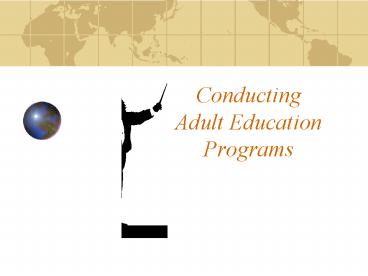Conducting Adult Education Programs - PowerPoint PPT Presentation
1 / 22
Title:
Conducting Adult Education Programs
Description:
Truth: school administrators may have other ideas about when and for what reason ... Insufficient budgeting upsets administrators. Incentive plans: ... – PowerPoint PPT presentation
Number of Views:48
Avg rating:3.0/5.0
Title: Conducting Adult Education Programs
1
ConductingAdult Education Programs
2
Where We Have Been....
- Historical philosophical foundations
- Characteristics of adult learners
- Learning principles
- Teaching methods
- Needs assessment
- Instructional design
- Planning programs
3
After all that, whats left to do?
- Nike says, just do it!!
- Successful adult educators know better.
- Harbstreit (Birkenholz, 1999) defines seven top
issues to consider when conducting AE programs.
4
The Top Seven Issues
- Putting the plan into action.
- Working with budgets.
- Scheduling facilities and personnel.
- Working with other staff members.
- Connecting with industry.
- Planning for professional growth.
- Balancing work with family.
5
Putting the Plan into Action
- What facilities are needed in your AE program?
- When does the AE program begin?
- How long will each session last?
- What are the dates of your AE program?
- What are the arrangements for meeting rooms?
6
Putting the Plan into Action
- What resource persons are needed? When are they
needed? - How will participants be involved?
- What materials, supplies, equipment, and teaching
aids will be needed for your AE program? - What type of refreshment breaks are needed?
- How will your AE program be promoted?
7
Scheduling Facilities Personnel
- Misconception my regular facilities (educators)
will be available for evening AE classes. - Truth school administrators may have other ideas
about when and for what reason to use facilities. - Plan to schedule dates and times for the AE
program. - Failure to reserve facilities causes confusion,
delays, etc.
8
Scheduling Facilities Personnel
- Carefully select AE meeting rooms for comfort.
- Arrange rooms to facilitate adult learning.
- Resource persons should be provided with
directions and maps to the meeting place.
9
Working with Budgets
- Most AE programs involve financial management.
10
More Budgets
- Many AE programs must pay their own way.
11
More Budgets
- Always consider
- Costs of providing instruction (instructors
fee). - Facility costs.
- Number, type, and cost of supplies.
- Other fees (membership fees).
- Field trip or other activity costs in the AE
program. - Expected enrollment (limited number or open).
- Promotion costs or evaluation costs.
12
More Budgets
- Each item should be addressed.
- All costs should be determined prior to contracts.
13
More Budgets
- Insufficient budgeting upsets administrators.
- Incentive plans
- Educator is paid more over the enrollment
threshold. - Instructors are encouraged to actively promote
program. - Increased number of participants in AE program.
- Community and/or profession benefits from
increased exposure through successful AE programs.
14
Working with Other Staff
- Involve colleagues and other staff.
- Collaboration is the key to successful AE
programs.
15
Working with Other Staff
- Always consider
- What is the expertise of other staff members?
- When are staff members available for assistance?
- What personal/family issues should you consider?
- What can you offer other staffers in exchange for
help? - Remember, not all staff members may be willing or
able to help with your AE program.
16
Connecting with Industry
- Industry partnerships are critical to AE
programs. - Access to cutting edge technology.
- AE participants may be depending on skill
upgrades.
17
Connecting with Industry
- Use an advisory committee from industry.
- Ensures your AE program is relevant and current.
- Utilize industry contacts and resources to build
a network of additional industry linkages. - Personal contact is best for establishing
contacts. - First contact should be informative (explain AE
program). - Second contact should be to ask for support.
18
Professional Growth
- Long-term success of AE depends on the educator.
- Well prepared and competent.
- Provide instruction, leadership, and motivation
to learn. - Develop your own plan to stay current.
19
Professional Growth
- Attend state/national conferences and workshops.
- Boost morale and enthusiasm for instructing
adults. - Administrative support is essential (and
expected). - Adult educators must walk the walk.
- Active participation in lifelong learning
opportunities. - Enhancing your own learning through AE programs.
20
Balancing Work Family
- Many AE programs happen outside the 9 to 5.
- Participants may have family emergencies.
21
Balancing Work Family
- Educators may not have the same luxuries.
- Consider
- Involve family members if possible (banquets,
trips). - Family member may contribute in AE instruction.
- Consider family events before planning AE
programs. - Avoid over-scheduling (workaholic syndrome).
- Participants are human too They realize you have
to balance a personal life with the demands of AE
programs.
22
Summary
- Conducting AE programs involves a variety of
activities past the needs assessment and program
planning stages. - Putting the plan into action requires attention
to details. - Budgets.
- Scheduling facilities and personnel.
- Working with support staff.
- Connecting with industry.
- Professional growth and development.
- Balancing work and family life.































